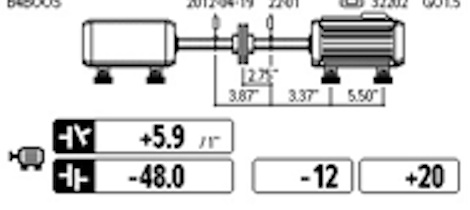In alignment, the feet of the moveable machine are often referred to in this manner:
- those closest to the coupling are called inboard, coupling side, shaft side, or drive end.
- those farthest from the coupling are referred to as outboard, opposite coupling side, opposite shaft side, or opposite drive end.
I learned them as inboard and outboard. But regardless of what you call them, it is important to note that “inboard” or “outboard” are planes, not feet.
Once soft foot has been checked and corrected, and the initial alignment values have been measured, the inboard two feet will be changed up or down by the same amount of shims, as will the outboard two feet.
In this example, the inboard plane is 12 mils too low, which means we will add 12 mils. The outboard plane is 20 mils too high, which means we must remove 20 mils. Whatever we do to one inboard foot, we must do to the other. The same is true of the outboard feet. We must shim in planes, not feet.
Think of it this way – when we make a horizontal correction, we can not move the left inboard foot horizontally more or less than we can move the right inboard foot, they must go together. The same is true of the vertical correction.
For more information, visit VibrAlign.com




